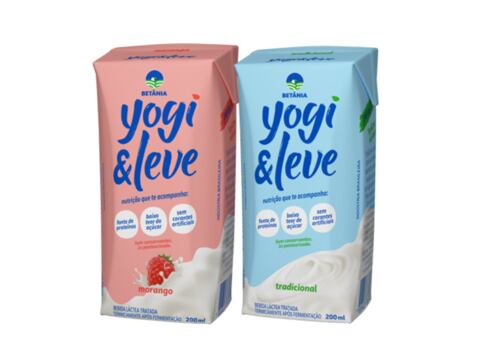Betânia, which enjoys a 40% market share in UHT dairy products in the north-east region of Brazil, launched the ambient drinking yogurt, Yogi & Leve, this summer.
The company worked with Tetra Pak to develop a customized processing solution for the product at the Switzerland-headquartered packaging giant’s facility in Monte More near Sao Paulo.
Betânia’s CEO, Bruno Girão, said it has reaped the benefits of switching to ambient.

“By converting chilled yogurt into ambient, we can now sell our products in north-eastern Brazil without having to invest in a costly chilled distribution chain. It’s an innovative approach that is helping us expand our business,” he said.
Available in two flavors – original and strawberry – the ambient drinking yogurts can be stocked by small stores that do not have refrigeration units, widening Betânia’s potential reach.
Cold chain challenges
Having a well maintained cold chain can be a challenge in the region both due to the distance products have to travel and the lack of infrastructure investment, according to Monica Ganley, principal at agri-food consultancy Quarterra.
“Having room temperature dairy products can prevent huge economic losses when an area experiences a loss of electricity, for example,” she told FoodNavigator-LATAM.
Brazilian food business operators discovered this last year during the Brazilian truck strike, which resulted in significant economic losses. According to the Brazilian Dairy Products Association Viva Lácteos, the country’s dairy sector alone lost R$1.3bn and was forced to throw away more than 360 million liters of milk.
Nestlé also said it had “faced difficulties” during the trucker strike and that milk sourcing had been the most impacted chain during the strike.
Switching to ambient may require certain tweaks to a recipe, however, in order to maintain the same taste and texture.
Ambient products require stabilizers such as hydrocolloids if they are to have the sensory profile consumers expect, Miguel Ruiseñor, LATAM regional sales director at CP Kelco told this publication previously.
“[…] a cheap source of protein that you can transport without refrigeration is key for some companies,” he said. “But formulating that kind of product is not easy because if you don’t have some kind of stabilization system, the protein will lump and fall out of solution.
For Yogi & Leve, Betânia uses modified starch, pectin, and gellan gum.
Ganley said she would expect the level of consumer acceptance for ambient products to shift depending on the category. “For example, within fluid milk, UHT milk sold at room temperature is already quite popular in the region. Customers do not seem to have any negative association with the product. It might be a different challenge for a product like yogurt, that customers have always consumed cold.”
“Broadly speaking, making investments can be a challenge in the region, either for those wanting to invest in cold chain or processors wanting to invest in new processing capabilities,” Ganley added. “Economic and political instability, currency fluctuations, and (in some places) an economically precarious consumer. But of course, if the investment shows positive returns, then the project should be pursued.”

